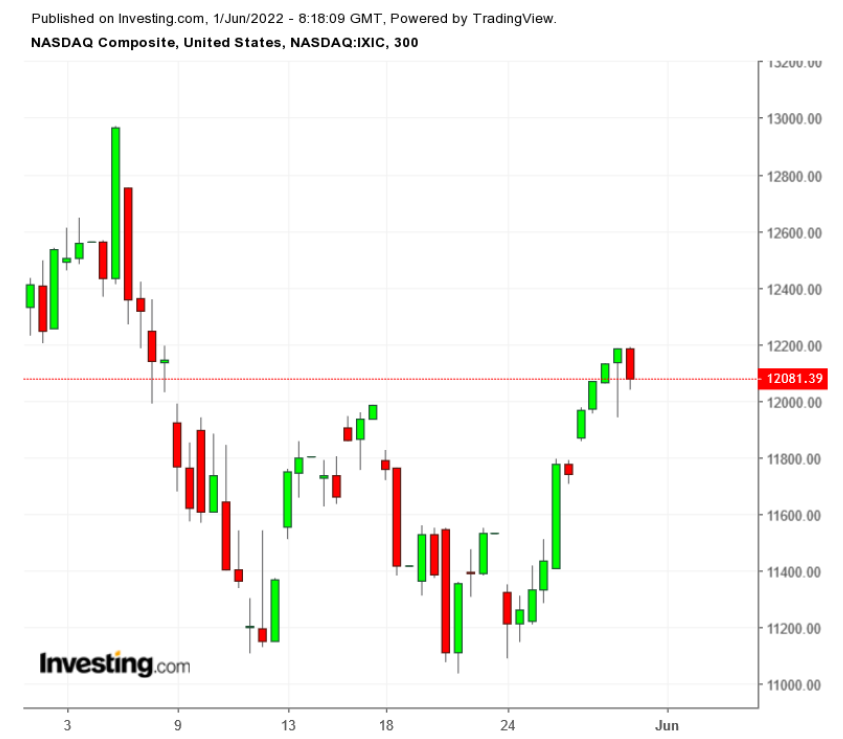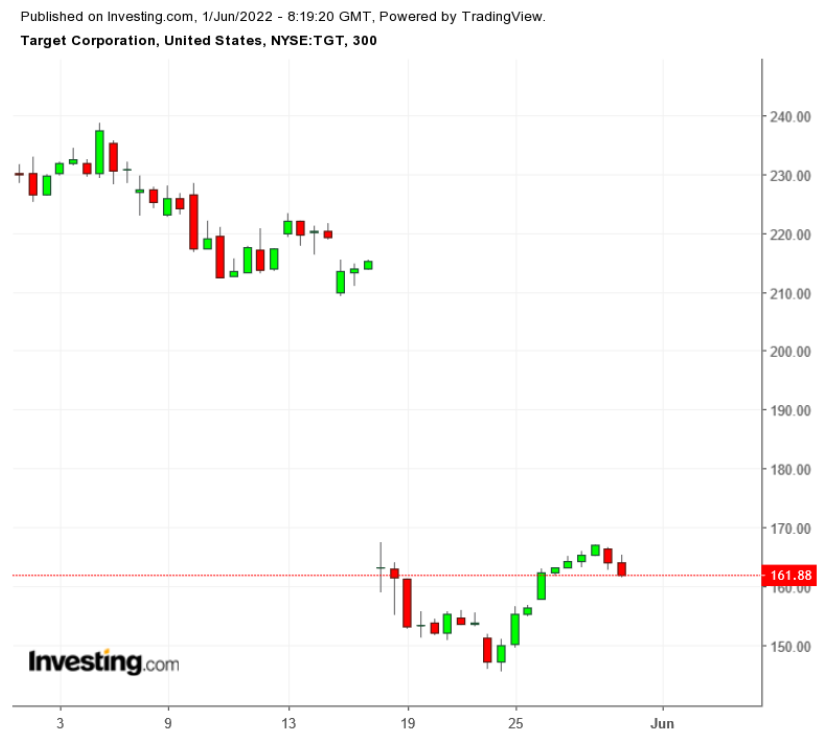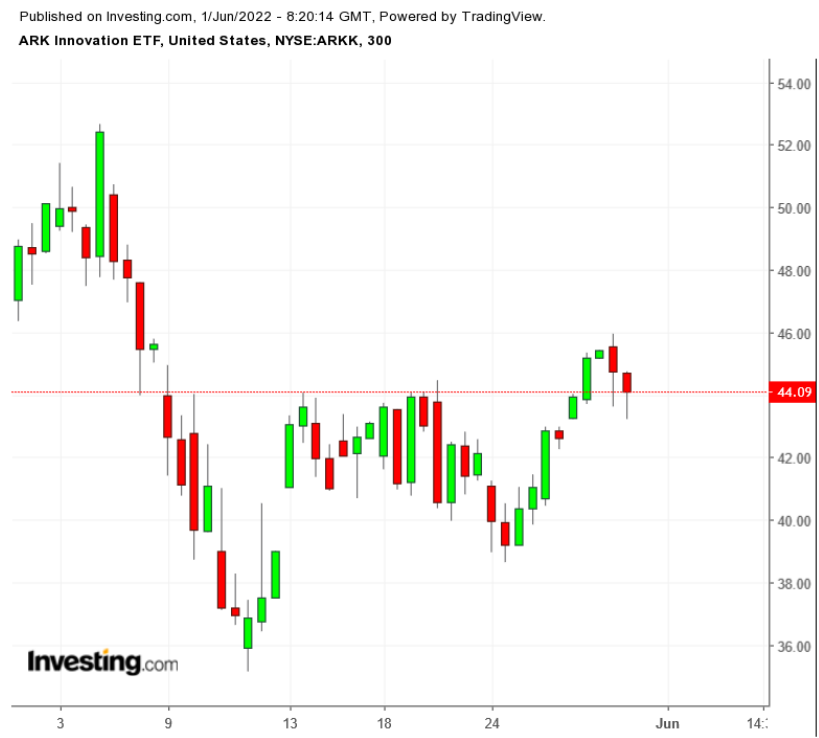For a brief, unhappy moment early in the afternoon of May 20, the hit 3,810.21, enough to push the broad market index to a loss of nearly 21% from its intraday peak set in January. A decline of 20% from a recent high is the popular definition of a bear market.
For investors who were paying attention over the longer term, the news brought back memories of two years ago, before the COVID pandemic erupted. At that time the index fell 35% in less than two months.
Luckily, the May 20 low prompted a big rally which continued during the following next week. The rebound broke a seven-week skid for the S&P 500 and the and an eight-week slump for the .
But after the Memorial Day holiday, the rally didn’t continue and US equity markets closed on Tuesday, the final trading day in May on a down note. The S&P 500 and the Dow slipped 0.63% and 0.67% on the day, respectively. Both indices finished the month flat.

The tech-heavy NASDAQ fell 0.4% on the day, ending the month down 2%, off 22.8% for the year.
What happens next is anyone’s guess. Wariness and watchfulness are good tactics.
Since 2022 began, the S&P and Dow have fallen in three of five months. The NASDAQ has been down four of five months. For all three indices, thus far, April was the worst month.
While COVID was the sole villain in 2020, factors pressuring markets in 2022 are more varied and complex. They include:
- Continuing domestic and global struggles with the pandemic.
- The worst since the 1980s and a vow from the Federal Reserve to bring rising prices to heel.
- The ongoing war between Ukraine and Russia.
- Political tensions in the United States.
- Overbought markets.
It’s all connected
COVID has proved a wily adversary, mutating into new variants easily and pushing case counts higher around the world. In May, China locked down a number of cities, especially Shanghai. The one bit of good news: more is known now about the virus.
Still, hospitalizations are rising and there are renewed calls for mask wearing in indoor public spaces, but COVID-related fatalities are moderating.
Nevertheless, the inflation issue also started with COVID, which disrupted global supply chains, making sending goods from point-A to point-B more time-consuming and expensive. Reopening has proved to be messy.
Plus, oil prices took off, with increases accelerating when Russia invaded Ukraine in late February.
West Texas Intermediate, the benchmark , jumped 10%. , the global benchmark, was up nearly 13%. Both finished the month of May at around $115 a barrel. The American Automobile Association’s Daily Fuel Gauge report shows US retail gasoline prices up nearly 41% in 2022.
The Fed is widely thought to have started its inflating battle too late. Leaving rates just above 0% for nearly two years generated frantic, exuberant buying of everything from furniture to cryptocurrencies.
The central bank has raised once this year and is now expected to boost rates at least twice more. Lenders have pushed the rate on a 30-year fixed-rate mortgage to about 5.1% from 2.7% in August, according to Freddie Mac, one of the country’s biggest suppliers of capital to mortgage lenders.
Just as important, the Fed will start selling off its gargantuan inventory of government bonds. That will also add to the pressures pushing interest rates higher. (The Fed’s bond-buying that began during the pandemic put more cash into the economy.)
Russia’s invasion of Ukraine, meanwhile, has produced two issues: a humanitarian crisis in eastern Europe as millions of Ukrainians flee elsewhere; disrupted global agricultural markets since both Russia and Ukraine are major ag producers—the conflict has impacted supplies of wheat, sunflower seeds, and related commodities.
One can see the results in any supermarket. Ask mothers of newborns how hard it is to find baby formula.
Political tensions may well increase this fall as the United States holds its mid-term elections.
We raise the issue of overbought markets last because interest-rate cuts in 2020 to keep the global economy afloat also set off bouts of speculation of stocks, cryptocurrencies as well as houses, furniture, art, and the like.
The Fed’s disclosure of its rate-raising plans cut out the underpinnings of many of those markets.
A broad array of May equity losers
Walmart (NYSE:) fell 15.9% in May, the weakest Dow stock for the month. The giant discount retailer’s shares are off 11.1% for the year.

Rival Target (NYSE:) plunged 29.2% because of sky-high transportation costs and a costly bet on the wrong inventory. Amazon (NASDAQ:) dropped 16.7%.
Tesla (NASDAQ:) fell 12.9% for the month as CEO Elon Musk pursued his controversial bid to buy Twitter (NYSE:) and skepticism grew he was offering too much. Shares of the EV company are down 30% on the year. (Twitter fell 19.2% and is off 8.4% in 2022 because of the uncertainty.)
Meta Platforms (NASDAQ:), the parent of Facebook, fell a modest 3.4% in May. That was good news for the social media behemoth. The stock was off 10% in April and down 42% in 2022—and nearly 50% lower from its Sept. 1, 2021, peak of $384.33. (Meta’s ticker symbol will change to META before the June 9 market open.)
Startups and initial public offerings evaporated. Only eight IPOs priced in May, down from 23 during the same period a year ago, according to Renaissance Capital, which tracks IPOs. Since 2022 began only 34 IPOs have priced this year—down nearly 80% from last year. One big reason: Investors aren’t interested in investing in companies with little or no path to profitability.
Technology-focused exchange-traded funds also struggled. First among these ETFs was ARK Innovation (NYSE:), managed by Cathie Wood, whose mission is to suss out what she calls disruptive innovators.

The ETF’s biggest holding is Tesla; it also has big stakes in TV-streaming company Roku (NASDAQ:) and crypto exchange Coinbase Global (NASDAQ:).
ARK was off 5.5% for the month, down about 33% this quarter, and worse, 54% YTD, plus, off 67% since peaking at $132.50 on June 30, 2021.
ARK’s woes mirror what happened to riskier stocks and investments, including cryptocurrencies.
fell 17.2% to $31,757 to finish out the month of May. But that’s a big improvement from its $28,158 low hit on May 26—representing a 26.5% decline at the time. The dominant cryptocurrency is still down 31% for the year and 54% from its November peak.
Stock market winners: not big tech
May wasn’t all bad. The month’s last full trading week produced the biggest weekly gains for the S&P 500 and the Dow since November 2020. The NASDAQ’s 8.2% gain for the week was its best since mid-March.
May’s winners were dominated by energy companies but also included chemical producers, utilities, and information technologies.

Specialty chemical manufacturer Albemarle (NYSE:), which produces lithium, used in batteries, was the top S&P 500 stock, up about 35% for the month. The second was oil-and-gas producer Devon Energy (NYSE:), up 28.8%. It was the leader among five oil and gas companies in the S&P’s top 10.
Oil giant Chevron (NYSE:) topped among Dow stocks, up 11.5%.
Crude oil was up 10.8% for the month, and +48.9% for the year. The US Oil Fund (NYSE:), an ETF that tracks oil prices, also gained 10.8% and is up 55% for the year.
Factors pushing oil prices higher include struggles to get production back online from pandemic shutdowns. Plus, many US independent oil & gas producers have been working to please investors by boosting profits at the expense of production.
The bigger issue, of course, is that western countries are Russian oil and gas.
Rebound at hand?
Last week’s big rebound had many investors and pundits, including CNBC’s Jim Cramer and technical analyst Larry Williams, believing market charts suggest stocks have bottomed and are about to rebound strongly into December. The economy will get stronger, they argue. The shows few, if any, signs of deteriorating they say.
Maybe. But there remain a variety of strong headwinds facing markets.
As noted above, first there’s the Fed. Though it hopes to raise interest rates slowly in order to cool still-hot inflation without too much economic distress, there are already signs escalating rates are starting to dampen home-buying.
Then, there’s still COVID to worry about. And the unresolved Ukraine-Russia conflict which has the potential to spiral into a much larger conflagration.
Lastly, the stock market hasn’t really signaled a rebound is at hand. Look at the relative strength indexes for the S&P 500, Dow, and NASDAQ. RSI measures the speed—up or down—of price movements. In March 2009, the market bottomed when the RSIs of each of the three indexes fell below 30. And ahead of the 2008 market collapse, market exuberance a year earlier pushed RSI values well above 70.
RSI values topped 70 in November 2021 and promptly fell when the Fed announced its more hawkish thinking on inflation. During the current May sell-off, indexes stayed above 30 even into May 20, when the S&P 500 looked like it was falling into a bear market.
Old hands in the markets will tell you that if you want a true rebound, first there needs to be a blowout. Perhaps it happened on May 20. But then again, maybe not.


